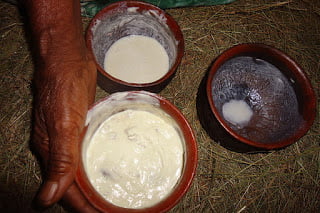We asked the team at Classic Africa Safaris to share a celebratory dish eaten in Uganda. Eshabwe is a delicacy that originated with the Bahima people of Ankole in western Uganda, though now it’s enjoyed throughout the country for special ceremonies or occasions. It began as a traditional wedding delicacy enjoyed by the groom and his father during the introduction ceremony (Kuhingira). However, this has changed and eshabwe is served like any other dish to everyone. Eshabwe is served as a condiment with the main course alongside millet bread (karo), potatoes, matooke, beans and others.
Eshabwe is a thick white sauce made from salt and mature ghee. The ingredients are very basic – mature ghee and a solution of rock salt and table salt. However, not any mature ghee can be used – the cook must be sure of the source, as eshabwe is made from unboiled ghee. The ghee must be extremely clean with no traces of any foreign matter whatsoever, such as specks of dirt, whey or even the remains of the water used to wash it. It must also be prepared using clean utensils and stored in a clean, dry container, until required. In short strict hygiene is paramount!
Ingredients
250g clean, mature ghee
150ml (10 tbsp) warm, previously boiled water
5ml spoon (1 tsp) powdered rock salt
½ tsp table salt
Method
- Dissolve both the rock and table salt in 75ml (half) the warm water. The water should be at room temperature.
- Sieve the solution with two nylon sieves to trap any impurities in the salt.
- Put the ghee in a small, clean bowl and stir it briskly with a small wooden masher in one direction, until smooth. If you do not have one, use a wooden spoon instead.
- Add the salt solution, a tablespoonful at a time, stirring briskly after each addition. The ghee should begin to thicken and turn white.
- Continue adding little of the salt solution and stirring briskly until the ghee increases in volume, and becomes smooth, thick and pure white.
- If the ghee curdles (looks like spoiled milk), add a little more salt solution with some water at room temperature. All this should be done gradually, a little at a time.
- When the eshabwe has doubled in volume, is very thick, creamy and pure white, taste a little and add a pinch of table salt if necessary. You may dilute the sauce a little with the remaining water (room temperature) but this should be done a tablespoonful at a time, stirring well after each addition. If it is still too thick, dilute further with previously boiled, tepid water, but the final product should be a sauce that is thick and not runny.
- Sieve with a fine sieve into a clean bowl and serve as a side dish with steaming hot mashed plantain (matooke), millet bread (kalo), cassava, sweet potatoes, a sauce of your choice and greens.




Leave A Comment
You must be logged in to post a comment.